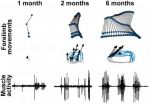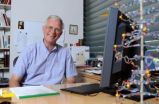(Press-News.org) A study led by researchers in the Department of Neurosciences at the University of California, San Diego School of Medicine shows unexpected and extensive natural recovery after spinal cord injury in primates. The findings, to be published November 14 in the advance online edition of Nature Neuroscience, may one day lead to the development of new treatments for patients with spinal cord injuries.
While regeneration after severe brain and spinal cord injury is limited, milder injuries are often followed by good functional recovery. To investigate how this occurs, UC San Diego and VA Medical Center San Diego researchers studied adult rhesus monkeys. The team was surprised to see that connections between circuits in the spinal cord re-grew spontaneously and extensively, restoring fully 60% of the connections 24 weeks after a mild spinal cord injury.
"The number of connections in spinal cord circuits drops by 80 percent immediately after the injury," said Ephron Rosenzweig, PhD, assistant project scientist in UCSD Department of Neurosciences. "But new growth sprouting from spared axons – the long fibers extending from the brain cells, or neurons, which carry signals to other neurons in the central nervous system – restored more than half of the original number of connections." He added that this was particularly surprising since the phenomenon does not appear in rodents – the traditional study model.
The research was led by Rosenzweig and Gregoire Courtine of the University of Zurich in Switzerland. Senior study director was Mark H. Tuszynski, MD, PhD, professor of neurosciences and director of the Center for Neural Repair at UC San Diego, and neurologist at the Veterans Affairs San Diego Health System.
It was not previously known that an injured spinal cord could naturally restore such a high proportion of connections. More profoundly, the spontaneous recovery was accompanied by extensive recovery of movement on the affected side of the body. Tuszynski said the team is now investigating how the nervous system is able to generate so much natural growth after injury. This knowledge could lead to development of drugs or genes that could transmit high-growth signals to spinal cord damage sites after more severe spinal cord injury.
The work highlights an important role for primate models in translating basic scientific research into practical, therapeutic treatments for people. The spinal cords of humans and other primates are different from rodents, both in overall anatomy and in specific functions. For example, the corticospinal tract – a collection of nerve cell fibers linking the cerebral cortex of the brain and the spinal cord – is much more important for muscle movement in primates than in rats.
"With similar injuries, rodents show much less regrowth and recovery of limb function," said Rosenzweig. The challenge now is to determine what exactly is prompting neuronal axons to sprout new connections, leading to recovered movement. That has exciting clinical relevance, Rosenzweig said, because discoveries resulting from further research could be applied to patients with severe injury to their central nervous system.
INFORMATION:
Additional contributors to the study include John H. Brock and Darren M. Miller, UCSD Department of Neurosciences; Gregoire Courtine, UCLA and University of Zurich; Devin L. Jindrich, Roland R. Roy, Leif A. Havton and V. Reggie Edgerton, UCLA; Adam R. Ferguson, Yvette S. Nout, Michael S. Beattie, and Jacqueline C. Bresnahan, UC Davis; and Sarah C. Strand, UC San Francisco.
This study was supported by the National Institutes of Health, the Veterans Administration, California Roman-Reed funds, the Bernard and Anne Spitzer Charitable Trust, and the Dr.Miriam and Sheldon G. Adelson Medical Research Foundation.
Research uncovers extensive natural recovery after spinal cord injury
2010-11-15
ELSE PRESS RELEASES FROM THIS DATE:
Pitt-led team develops nanoscale light sensor compatible with 'Etch-a-Sketch' nanoelectronic platform
2010-11-15
PITTSBURGH—University of Pittsburgh researchers have created a nanoscale light sensor that can be combined with near-atomic-size electronic circuitry to produce hybrid optic and electronic devices with new functionality. The team, which also involved researchers from the University of Wisconsin at Madison, reports in Nature Photonics that the development overcomes one of nanotechnology's most daunting challenges.
The group, led by Jeremy Levy, a professor of physics and astronomy in Pitt's School of Arts and Sciences, fashioned a photonic device less than 4 nanometers ...
Vitamin D deficit doubles risk of stroke in whites, but not in blacks
2010-11-15
Low levels of vitamin D, the essential nutrient obtained from milk, fortified cereals and exposure to sunlight, doubles the risk of stroke in whites, but not in blacks, according to a new report by researchers at Johns Hopkins.
Stroke is the nation's third leading cause of death, killing more than 140,000 Americans annually and temporarily or permanently disabling over half a million when there is a loss of blood flow to the brain.
Researchers say their findings, to be presented Nov. 15 at the American Heart Association's (AHA) annual Scientific Sessions in Chicago, back ...
Synchronizing a failing heart
2010-11-15
OTTAWA – November 14, 2010 – One of the largest, most extensive worldwide investigations into heart failure, led by the University of Ottawa Heart Institute (UOHI), conclusively proves that a new therapeutic implant synchronizes and strengthens a fading heart beat while reducing risk of death by 24% compared to the current treatment.
The research, co-led by Dr. Anthony Tang and Dr. George Wells at the Heart Institute, brings the promise of life-saving treatment for patients with symptoms of mild to moderate heart failure – an increasingly common condition among an aging ...
Molecular fossil
2010-11-15
In today's world of sophisticated organisms proteins are the stars. They are the indispensible catalytic workhorses, carrying out the processes essential to life. But long, long ago ribonucleic acid (RNA) reigned supreme.
Now Northwestern University researchers have produced an atomic picture that shows how two of these very old molecules interact with each other. It is a rare glimpse of the transition from an ancient, RNA-based world to our present, protein-catalyst dominated world.
The scientists are the first to show the atomic details of how ribonuclease P (RNase ...
DNA sequence variations linked to electrical signal conduction in the heart
2010-11-15
Scientists studying genetic data from nearly 50,000 people have uncovered several DNA sequence variations associated with the electrical impulses that make the heart beat. The findings, reported in Nature Genetics, may pave the way for a greater understanding of the mechanisms for abnormal heart rhythms and sudden cardiac death.
"Regulation of the heart's rhythm is exceedingly complex," says co-author Glenn I. Fishman, MD, the William Goldring Professor of Medicine and the director of the Leon H. Charney Division of Cardiology at NYU Langone Medical Center. "This study ...
Poor sleep quality increases inflammation, community study finds
2010-11-15
People who sleep poorly or do not get enough sleep have higher levels of inflammation, a risk factor for heart disease and stroke, researchers have found.
Data from a recent study are scheduled to be presented Sunday, Nov. 14 at the American Heart Association Scientific Sessions in Chicago by Alanna Morris, MD, a cardiology fellow at Emory University School of Medicine.
The results come from surveying 525 middle-aged people participating in the Morehouse-Emory Partnership to Eliminate Cardiovascular Health Disparities (META-Health) study on their sleep quality and sleep ...
Patients receiving dialysis are at a heightened risk for sudden cardiac death
2010-11-15
Approximately 500,000 Americans require dialysis to treat kidney disease; of that population nearly half of the deaths that occur are caused by cardiovascular disease. Dialysis patients are at elevated risk for sudden cardiac death, but physicians are unclear why these deaths occur because little research has been done to examine how to best manage heart disease in this high-risk population.
Northwestern Medicine cardiologist Rod Passman, MD, medical director for the Center for Atrial Fibrillation at the Bluhm Cardiovascular Institute of Northwestern Memorial Hospital ...
A new read on DNA sequencing
2010-11-15
The twisting, ladder-like form of the DNA molecule—the architectural floor plan of life—contains a universe of information critical to human health. Enormous effort has been invested in deciphering the genetic code, including, most famously, the Human Genome Project. Nevertheless, the process of reading some three-billion nucleotide "letters" to reveal an individual's full genome remains a costly and complex undertaking.
Now biophysicist Stuart Lindsay, of the Biodesign Institute at Arizona State University, has demonstrated a technique that may lead to rapid, low cost ...
Tiny molecules protect from the dangers of sex
2010-11-15
DURHAM, N.C. – Pathogenic fungi have been found to protect themselves against unwanted genetic mutations during sexual reproduction, according to researchers at Duke University Medical Center. A gene-silencing pathway protects the fungal genome from mutations imposed by a partner during mating.
This pathway was discovered in Cryptococcus neoformans, a fungus that commonly infects humans, causing over one million cases of lung and brain infection each year, and more than 600,000 deaths. A related species, Cryptococcus gattii, is causing an expanding outbreak in the Pacific ...
Penn study: Hospital CPR quality is worse at night
2010-11-15
Other study authors include Sarah Perman, MD, Douglas Smith, Marion Leary, RN, and Lance Becker, MD, at the University of Pennsylvania, and Noah Swann and Dana Edelson, MD at the University of Chicago.
CONTACT:
At the AHA Scientific Sessions
Jessica Mikulski
C: 215-796-4829
Email: Jessica.mikulski@uphs.upenn.edu
Following the Scientific Sessions
Holly Auer
O: 215-349-5659
C: 215-200-2313
Email: holly.auer@uphs.upenn.edu
Penn Medicine is one of the world's leading academic medical centers, dedicated to the related missions of medical education, biomedical ...

